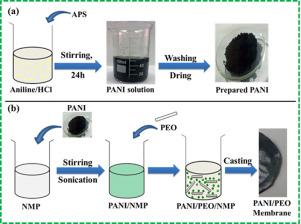Colloid and Interface Science Communications ( IF 4.5 ) Pub Date : 2020-09-10 , DOI: 10.1016/j.colcom.2020.100314 Eman S. Mansor , Heba Ali , Ahmed Abdel-Karim

|
The endless introduction of toxic dyes through industrialization has worsened the dyes pollution in the environment. As a consequence, the need for the effective removal of such dyes has become more crucial than before. Recently, polymeric membranes for dye adsorption are gaining tremendous attention. In this context, we synthesized the polyethylene oxide/polyaniline (PEO/PANI) composite membrane by a very simple and cost effective approach for the first time. The removal of methyl orange (MO) dye onto pure PEO and composite membrane was conducted utilizing batch mode. The results proposed that the uptake efficiency of PEO after hybridization with PANI is more than two times higher than that of the unmodified PEO membrane under the same experimental conditions. The effect of changing the adsorbent dose (1.5, 2, 2.5, 3 g/L), pH (3, 5, 6.5, 9, 11), and dye concentration (2.5, 5, 7.5, 10 mg/L) on the adsorption performance of the composite membrane was studied. The reusability studies proved that within 50 min of adsorption period the PEO/PANI composite membrane can retain 99% removal percentage for 8 cycles. This indicates that the low cost composite membrane has a good recyclability, which represents a crucial feature for the sorption technique to remove dyes from wastewater streams. Additionally, the proposed adsorption mechanism was discussed. Finally, the as-synthesized PEO and PEO/PANI was tested as a pressure filtration membrane using a cross-flow filtration system. The results revealed that the incorporation of PANI improved the dye rejection by 82.5% compared to that of the pure PEO membrane.
中文翻译:

高效可重复使用的聚环氧乙烷/聚苯胺复合膜,用于染料的吸附和过滤
通过工业化不断引入有毒染料,使环境中的染料污染更加恶化。结果,有效去除这种染料的需求变得比以前更加关键。近来,用于染料吸附的聚合物膜受到极大关注。在这种情况下,我们首次通过非常简单且经济高效的方法合成了聚环氧乙烷/聚苯胺(PEO / PANI)复合膜。使用间歇模式将甲基橙(MO)染料去除到纯PEO和复合膜上。结果表明,在相同的实验条件下,与PANI杂交后PEO的吸收效率是未改性PEO膜的两倍以上。改变吸附剂剂量(1.5、2、2.5、3 g / L),pH(3、5、6.5、9、11)的影响,研究了染料浓度(2.5、5、7.5、10 mg / L)对复合膜吸附性能的影响。可重复使用性研究证明,在吸附时间的50分钟内,PEO / PANI复合膜可在8个循环中保持99%的去除率。这表明低成本复合膜具有良好的可回收性,这代表了从废水中去除染料的吸附技术的关键特征。此外,讨论了提出的吸附机理。最后,使用错流过滤系统将合成后的PEO和PEO / PANI作为压力过滤膜进行测试。结果表明,与纯PEO膜相比,PANI的引入使染料的排异率提高了82.5%。10 mg / L)对复合膜的吸附性能进行了研究。可重复使用性研究证明,在吸附时间的50分钟内,PEO / PANI复合膜可在8个循环中保持99%的去除率。这表明低成本复合膜具有良好的可回收性,这代表了从废水中去除染料的吸附技术的关键特征。另外,讨论了所提出的吸附机理。最后,使用错流过滤系统将合成后的PEO和PEO / PANI作为压力过滤膜进行测试。结果表明,与纯PEO膜相比,PANI的引入使染料的排异率提高了82.5%。10 mg / L)对复合膜的吸附性能进行了研究。可重复使用性研究证明,在吸附时间的50分钟内,PEO / PANI复合膜可在8个循环中保持99%的去除率。这表明低成本复合膜具有良好的可回收性,这代表了从废水中去除染料的吸附技术的关键特征。另外,讨论了所提出的吸附机理。最后,使用错流过滤系统将合成后的PEO和PEO / PANI作为压力过滤膜进行测试。结果表明,与纯PEO膜相比,PANI的引入使染料的排异率提高了82.5%。可重复使用性研究证明,在吸附时间的50分钟内,PEO / PANI复合膜可在8个循环中保持99%的去除率。这表明低成本复合膜具有良好的可回收性,这代表了从废水中去除染料的吸附技术的关键特征。此外,讨论了提出的吸附机理。最后,使用错流过滤系统将合成后的PEO和PEO / PANI作为压力过滤膜进行测试。结果表明,与纯PEO膜相比,PANI的引入使染料的排异率提高了82.5%。可重复使用性研究证明,在吸附时间的50分钟内,PEO / PANI复合膜可在8个循环中保持99%的去除率。这表明低成本复合膜具有良好的可回收性,这代表了从废水中去除染料的吸附技术的关键特征。此外,讨论了提出的吸附机理。最后,使用错流过滤系统将合成后的PEO和PEO / PANI作为压力过滤膜进行测试。结果表明,与纯PEO膜相比,PANI的引入使染料的排异率提高了82.5%。这代表了从废水中去除染料的吸附技术的关键特征。此外,讨论了提出的吸附机理。最后,使用错流过滤系统将合成后的PEO和PEO / PANI作为压力过滤膜进行测试。结果表明,与纯PEO膜相比,PANI的引入使染料的排异率提高了82.5%。这代表了从废水中去除染料的吸附技术的关键特征。另外,讨论了所提出的吸附机理。最后,使用错流过滤系统将合成后的PEO和PEO / PANI作为压力过滤膜进行测试。结果表明,与纯PEO膜相比,PANI的引入使染料的排异率提高了82.5%。



























 京公网安备 11010802027423号
京公网安备 11010802027423号